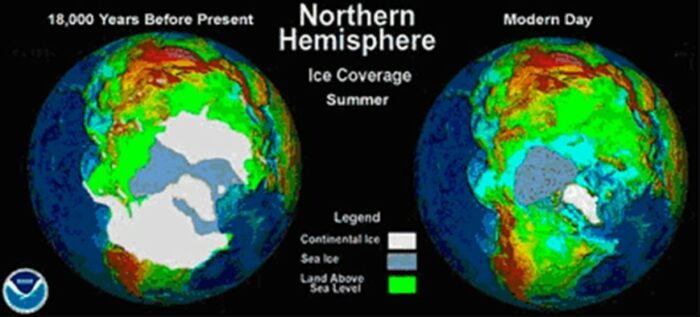
Depiction of ice coverage 18,000 years ago vs modern day (NOAA)
Some sceptics say that climate change is a wholly natural occurrence, pointing to past glacial cycles as evidence. It is not that simple. While glacial cycles follow a recurring long-term pattern, they are complex, and their drivers are not fully understood. Recent research suggests that current models of glaciation could be simplified and taking a different approach could help in determining what role glacial cycles play alongside human-driven climate change.
In “Understanding glacial cycles: A multivariate disequilibrium approach”, Robert Kaufmann (Boston University) and Felix Pretis (University of Victoria), take a fresh look at the dynamics of glacial cycles using ice core data.1 Observing long time-series data up to 790,000 thousand years ago, they use statistical methods to provide further insights into glacial dynamics.
The models employed by Kaufmann and Pretis estimate the disequilibrium (i.e. imbalance) between observed climate and Earth’s orbital configuration. If orbital arrangements were fixed, Earth would approach an equilibrium (i.e. constant) ice level. Instead, levels of ice change as Earth’s orbit keeps changing. With every change, comes a new equilibrium, and it takes a while for ice to catch up. Since the equilibrium is regularly shifting, the ice is stuck in a cat-and-mouse game in which it chases an ever-changing equilibrium. To estimate the relationship between observed climate, the implied equilibrium, and the Earth’s orbital systems, the authors use an empirical model – a statistical tool that looks for trends or patterns in the data.
Overall, they find a strong connection between the Earth’s orbital systems (particularly the Earth’s axial tilt) and ice levels. However, when looking at any specific point in time specifically, the relationship between the Earth’s tilt and ice levels is weak.
The chances of entering an inter-glacial period can instead partly be explained by disequilibrium, which is the difference between observed ice levels and where the “ice wants to be”. The further ice is from where “it wants to be”, the more likely we are to see a glacial period.
The approach taken by the authors provides a simpler way to understand the relationship between the Earth’s orbital systems and climate and what role other factors might play. It also shows that it might not be necessary for models to include complex nonlinearities (such as thresholds) to describe changes in glacial cycles.
As we look to an uncertain future, having a better understanding of glacial cycles is important if we are to fully understand natural and human influences on our changing climate in the long run.
1 Kaufmann, R.K. and Pretis, F. (2021) ‘Understanding glacial cycles: A multivariate disequilibrium approach‘, Quaternary Science Reviews, 251.
 Felix Pretis, Co-Director, University of Victoria
Felix Pretis, Co-Director, University of Victoria
 Angela Wenham, Centre Manager, Nuffield College
Angela Wenham, Centre Manager, Nuffield College
